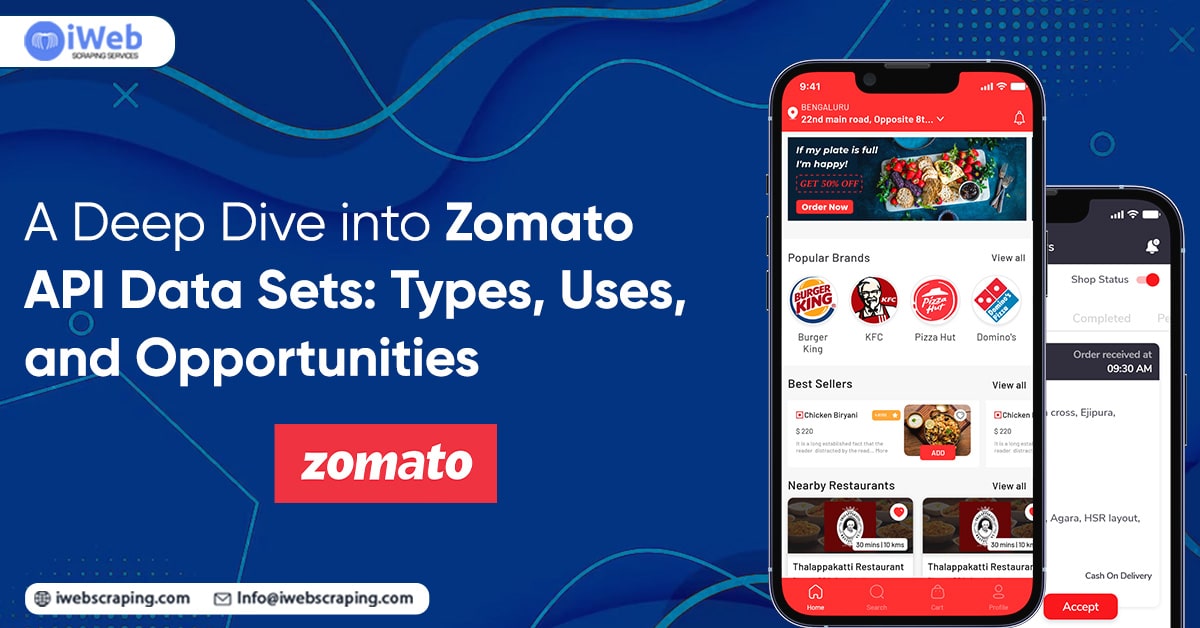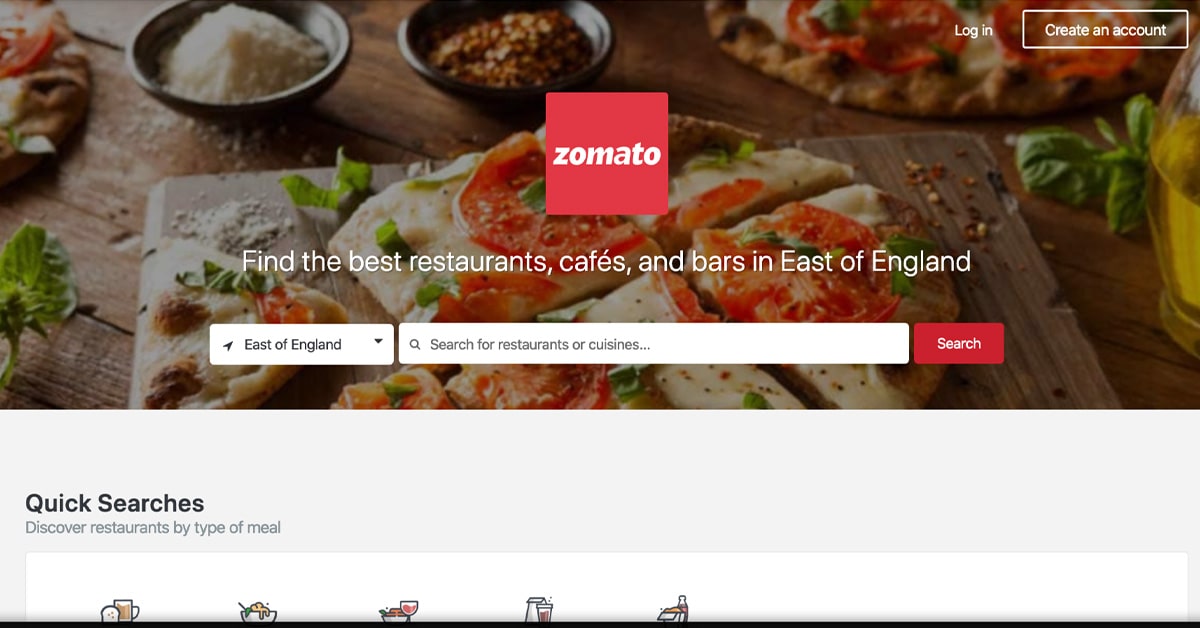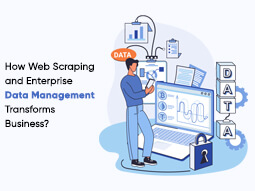Zomato API: Datasets, Types, Uses, and Opportunities

Technology has transformed everything, and the need to seek new opportunities comes with that. The internet is a two-way street, so it is no surprise that there are many blogs about what has been happening with Zomato Datasets. This blog will take you on a journey through the world of information. We begin at the type of data, followed by properties and potential uses for this data then finally, things to do with these insights so you can use them in your web or mobile app product launch or marketing plan.
We begin by breaking down the Datasets into types of data. There are three main types:
(1) Publicly accessible,
(2) Proprietary, and
(3) De-anonymized. Each one of these can be further broken down into sub-categories. So, let's get started.
Overview of Zomato and Zomato API

Zomato is a restaurant search and discovery platform. It was founded in India in 2008. 2017 Zomato had over 145 million monthly users and over 90,000 restaurant listings in 17 countries.
The company has offices in 17 different countries: the United States, Australia, New Zealand, the United Kingdom, Ireland, Canada, France, Italy, and Germany, among others. Techcrunch has reviewed Zomato as one of the top 100 startups in the world to work for by the Great Place to Work Institute four times consecutively since 2014.
Zomato API
The Scrape Zomato Restaurant Data API is an Application Programming Interface that allows developers to build applications using the restaurant data on Zomato. The API can get restaurant information using its geo search functionality, rating, menu, cuisine information, opening hours, booking, and reservation details. This data can be stored in a third-party database and used by web and mobile app developers. It has been used globally by companies such as Rabatak and Lazeeva, who have built apps on top of it that let you find a restaurant near your current location. It can also be used for other services, such as allowing users to check menus or get reviews for their restaurants. The Zomato API is RESTful and uses OAuth 2.0, making it straightforward.
Types of Zomato Datasets
Now that we know what Zomato is let's dive into the different types of Datasets. There are several ways to categorize datasets, but I have chosen to break down the Datasets into four main categories:
(1) Publicly accessible,
(2) Proprietary, and
(3) De-anonymized.
Publicly Accessible Datasets
There are many publicly available Datasets for free on Zomato's website. They include:
Location data:
This refers to metadata that can be collected from the physical location of a restaurant. It is made up of latitude and longitude coordinates.
Address:
The name and address of a restaurant, phone numbers, and website links, if available.
Rating:
An overall star rating of a restaurant on Zomato's platform, calculated by users who have rated it randomly across various criteria such as food, ambiance, service, etc. Ratings range from 1 to 5 stars, varying weighting for each criterion depending on the restaurant type.
Cuisine:
A restaurant listed on Zomato is classified by its cuisine. The cuisine is determined based on the type of food a restaurant serves and information from food bloggers, websites, and other sources. Cuisine types range from Mexican to French to Indian and much more.
Cuisine data can also be gathered from user reviews and reported by users.
The highest level of restaurant information from this data set is a list of restaurants from a given area or country. You can also get latitude; longitude coordinates for each restaurant, which can be used to build mapping applications. You can also see the average rating for the restaurant and other similar restaurants that serve similar cuisine.
Proprietary Datasets
Zomato has Datasets that are only available in its corporate network. They are:
Menu:
The full menu for a given restaurant, including pictures, prices, and ingredients, as well as basic information such as the type of location (small/big), dining capacity (small/big), available times (hours), and any special events that take place there.
Ratings:
The overall star rating of a restaurant by users in the form of 1-5 stars, with varying weighting for each criterion.
Reviews:
Reviews submitted by users that mention a specific location and cuisine and the average rating. This data set can help gather information on a restaurant's cuisine and how it is rated on Zomato.
Photos:
Photos of restaurants and other related information such as the official website, phone number, map location, and directions to the restaurant. You can also get restaurant videos as seen on YouTube or Vimeo on Zomato's website.
In addition to this, Zomato has published a set of 25,000 (in total) restaurants identified as "Top Performing Restaurants." These are the highest-rated restaurants on Zomato, rated above 4.5 stars. They have provided their list of restaurants here. As you can see, there are some interesting outliers, such as an Italian restaurant in Korea with an impressive 4.9 rating.
De-anonymized Datasets
The main feature of Zomato's API is being able to de-anonymize data. De-anonymized data is the raw data that is not being labeled but can still be used for machine learning, clustering, and classification. This type of data can help make predictions, for example, predicting the probability of a user ever making a restaurant booking.
This data set was made public by Zomato on April 13th, 2017. It contains the following de-identified information about restaurants:
Open Hours:
It includes the duration an application is available for business (Mon-Sun), whether it closes on Mondays and holidays, etc. It also stores information related to special events, such as support billing policies (if applicable).
Promotions:
Currently, there needs to be more information available for promotions.
Special Events:
This includes the dates of events such as food festivals, bookings for reservations, etc. This data can help you build an app that allows people not just to find restaurants but also to make reservations on those days or even find out when a restaurant has a booking and is open.
Zomato API Datasets: Uses and Opportunities
Depending on the data set you are extracting, there are different ways to use it. Some of these include using the data as is, using it to promote your restaurant, or using it to make predictions.
Using it as is:
You can use it as is or do something more advanced, like cluster similar restaurants based on your data. It will allow you to group all restaurants with similar ratings and types of cuisine and then group them based on revenue or other similar metrics to develop an algorithm that groups these restaurants to better make recommendations for you and your business.
You can use it for promotion:
If you can collect photos, videos, etc., from the best restaurants in your area, you can use marketing campaigns to promote these other restaurants on your website.
You can use it for predictions:
Using machine learning algorithms such as clustering and classification can help you promote restaurants or predict new trends based on large Datasets. This means you can expect which restaurants will be most successful before opening. You can then partner with them to ensure they are more successful than the rest of the industry, forming a valuable partnership.
Zomato's API is a valuable source of information that can be used to promote your restaurant or restaurant industry in general. You can encourage them by partnering with different restaurants and foodie blogs, especially high-rated ones. However, these partnerships need to be monitored so you do not violate Zomato's terms of service agreement. Therefore, it is recommended that you consult with a lawyer before beginning any partnerships with other companies and using Zomato API.
Conclusion
Zomato's dataset is de-anonymized, and you can use it to make many predictions. We have discussed some of the best Datasets that Zomato provides and the opportunities to use them. One important thing to note is that Zomato has been contacted about their API and has yet to respond up to this point. Therefore, you should check with them first before using their Datasets.
While Zomato has a stable API, it is limited in its scope and only provides a little data outside of restaurant bookings. It is also easier to get information about other types of restaurants by using many different parameters. For example, you can search for restaurants based on your budget or cuisine. Additionally, other competing sites provide better information and a more comprehensive range of data.




